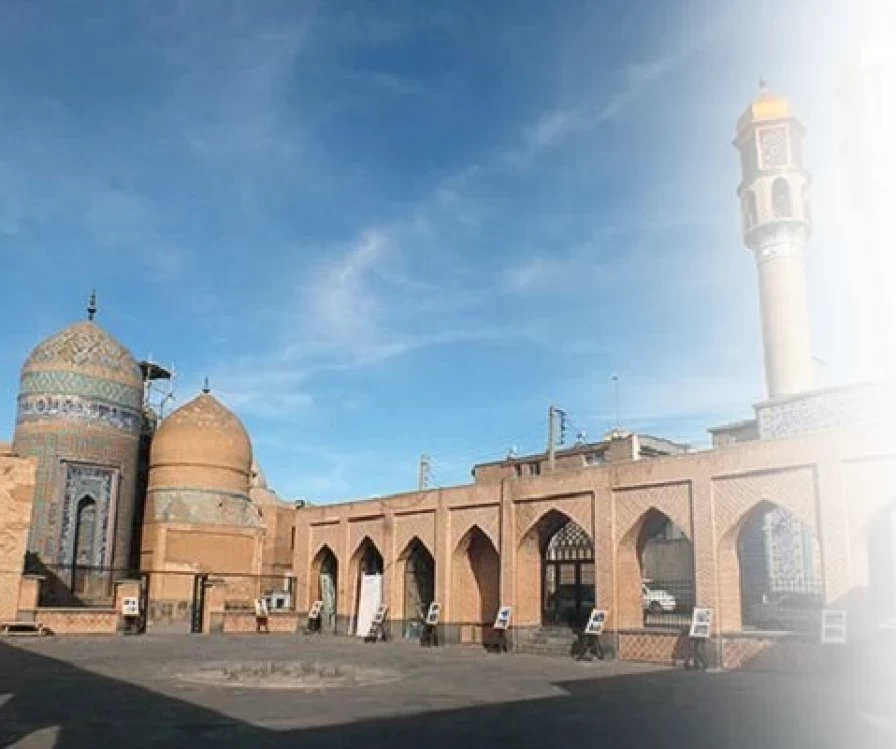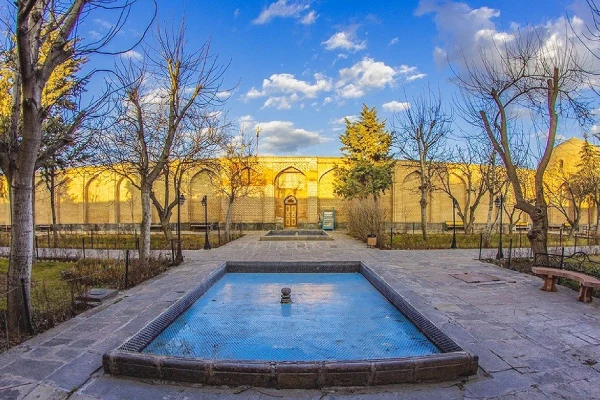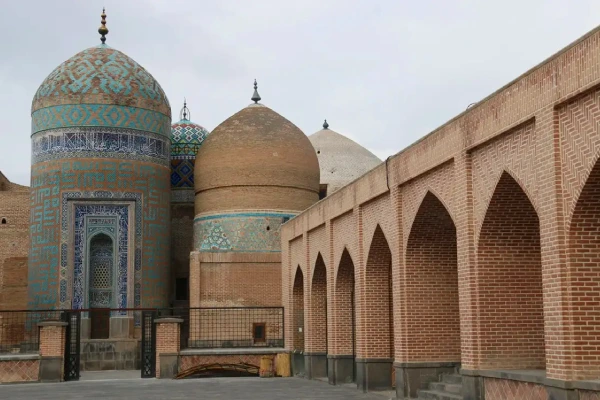
Sheikh safi alDin Ardabili mosque





Sheikh safi al-Din Ardabili Shrine
Among the historical treasures of Iran, some stand out like rare jewels in a precious collection. Among these gems, a few are particularly unique. Unfortunately, many of Iran's historical sites, primarily constructed from clay and brick, have suffered over time due to natural destructive forces such as floods, winds, rains, earthquakes, and countless other factors. As a result, most of the remaining historical sites date back to the Safavid and Qajar eras. Among the Safavid heritage, the shrine of sheikh Safi al-din khānegāh and shrine ensemble is one of the jewels previously mentioned. Therefore, visiting this shrine is a priority for any history enthusiast or art lover.
Before diving deeper, it's essential to understand the branches of Islam and the emergence of the Shia school within it. The Safavid dynasty is recognized as one of the greatest promoters of the Shia school in the history of Islamic Iran. The Emergence and Development of the Shia School in Islamic Iran
At the dawn of Islam, two main branches emerged: Shia Islam and Sunni Islam. Shia Islam began to take shape at the inception of Islamic law but did not develop as it should have for various reasons. This changed during the Safavid era when Shia practices expanded significantly throughout Iran.
The founders of the Safavid dynasty, who ruled Iran for nearly 400 years, were neighbors to the great Ottoman dynasty and played a crucial role in the spread of Shia Islam in Iran and other parts of the world.
Before the Safavid dynasty, the number of Shia Muslims in the Islamic world was limited, existing as small communities in Iran and other countries. However, with the rise of the Safavid dynasty, these communities merged and grew, resulting in the majority of today's Iranian population being Shia, with a smaller portion being Sunni and belonging to other faiths, including Christianity and Zoroastrianism. During the Safavid era, due to the rulers' emphasis on architecture and art, numerous artistic and literary works were created. Given Iran's strategic importance along the Silk Road, hundreds of mosques, caravanserais, bazaars, and numerous ancient scientific and commercial centers were established during this period.
Additionally, the belief in the afterlife and the significance of the hereafter in Islam led many to believe that visiting the tombs of the Prophet Muhammad's descendants and relatives would earn them spiritual rewards. Consequently, the tombs of many great figures and religious leaders in Iran became popular pilgrimage sites for Muslims and citizens. The tomb of Sheikh Safi al-Din Ardabili, the great ancestor of the Safavid dynasty, is significant not only because he was a prominent figure but also due to his importance as a mystic and dervish at that time, making his shrine a place of interest for many Muslims and Iranian citizens.
In this location, besides the tomb of Sheikh Safi al-Din Ardabili's shrine , there are also the graves of Shah Ismail I, his mother, several Safavid dignitaries, and some martyrs from the Battle of Chaldiran. Today, museums such as the China House, mosque, Jannat Sara, Khanqah, Cheleh House, Martyr's Place, and Lantern House have been established within this complex, enhancing its cultural and spiritual significance.
The foundation of this complex was laid in 725 AH by the son of the renowned mystic sheikh safi al-din khānegāh and shrine ensemble , Sadr al-Din Musa. After the construction of the first tomb, other Safavid princes who held great reverence for their ancestor added new structures to the complex. During the reign of Shah Abbas I, many additions were made due to his deep respect for his ancestor, resulting in the creation of beautiful works during this period in Iranian history.
One of the unique aspects of this complex is that it contains numerous works across various artistic disciplines, including exquisite tile work, muqarnas, and inscriptions by renowned calligraphers such as Mir Emad and Mir Qavam al-Din, as well as precious works like wood carving, silverwork, gilding, painting, and stone carving. This historical site is considered one of the most important architectural works in Iran, especially from the Safavid era.
During the Russian invasion of Iran in World War II, a significant portion of this complex was attacked, and many important parts, including its valuable library, were targeted. Many of its manuscripts were stolen, and the government was compelled to surrender all handwritten books and beautiful written works from the library as compensation to the Russian government. Additionally, some other artistic works from this collection, including a highly valuable historical carpet, were stolen by other nations, and this carpet is now housed in the Albert Hall Museum in London. Despite these losses, today this complex is regarded as one of the most valuable architectural and historical sites in Iran, attracting thousands of tourists, specialists, architects, and artists every year. This complex boasts unique assets and architecture that are rarely found in other parts of the world. It is in excellent condition, showcasing beautiful works such as intricate tile work, wood carving, stucco work, and unique paintings that captivate every viewer.
The blue and turquoise tiles cover most surfaces of this complex, and its unique stucco work mesmerizes visitors. While the domes, arches, and general principles of this structure follow the design of Safavid mosques and tombs, there is no doubt that such a complex, with its intricate details, is unique in Iranian architecture and art, making it hard to find similar examples in Iran or elsewhere. Another distinctive part of this complex is the China House, located next to the Lantern House in its eastern section. It features four royal alcoves adorned with four muqarnas arches, decorated with vibrant and beautiful paintings. In the past, this space was used to store porcelain gifts sent from China to the Safavid dynasty. It is worth noting that during the Safavid period, relations between Iran and China were at their peak. Given Iran's key role in the Silk Road, the emperors of China established a strong and special relationship with the Safavid government. Another unique feature of the Sheikh Safi al-Din Shrine is its significance as a sanctuary for individuals seeking refuge.
Even if someone was sentenced to execution or death by the government, if they sought refuge in this sacred place, they would not be attacked by their enemies as long as they remained there, effectively receiving a form of governmental pardon. This highlights the historical, religious, and cultural importance of this site. Unfortunately, due to Iran's weakness in the Treaty of Turkmenchay, many valuable artifacts from this complex were transferred to Russia. Nevertheless, it is undeniable that even with all these shortcomings, this complex is so valuable that it does not diminish the importance of visiting it.
Considering that Ardabil is one of the coldest regions in Iran, the best time to visit this complex is in spring and summer. In spring, Iran transforms into a paradise of flowers and natural blossoms, and Ardabil, due to its mountainous terrain, is considered a heavenly place. Moreover, given Iran's hot and dry climate, Ardabil becomes another paradise for weary travelers in summer. Overall, with its suitable infrastructure, Ardabil is regarded as a cultural and tourism hub, particularly in spring and summer, although visitors can also enjoy the city's attractions in winter. The presence of mineral springs around Ardabil makes visiting this historical city worthwhile even in winter.
As the provincial capital, Ardabil has unique transportation infrastructure. The Heyran road and pass are among the most beautiful roads in Iran. Numerous routes facilitate access to Ardabil. Ardabil has an airport, making it easy to reach this large city by air. Thanks to the international transport network, accessing Ardabil is very convenient. Ardabil offers suitable hotels, as well as guesthouses, boutique hotels, and traditional houses, accommodating tourists from all backgrounds and preferences. However, since this city is considered one of the main tourist destinations, it is advisable to ensure your accommodation before traveling.
Given the importance of this city, it is best to request travel agencies to reserve a safe and reliable place for you before your trip. Otherwise, you may encounter difficulties in finding accommodations and the best access routes. Our colleagues at the Sana Persian travel agency strive to treat you as a family member, providing the best plans in the best locations and conditions. We hope to accompany you soon in Ardabil while visiting the Sheikh Safi al-Din Shrine.
Our specialized team at the Sana Persian website is ready to assist you at all hours. If you plan to travel to Iran, it would be beneficial to visit the specialized Sana Persian website and benefit from our colleagues' experiences. There is no doubt that visiting Ardabil and the Sheikh Safi al-Din Shrine is an essential experience for every tourist. We look forward to seeing you in Iran and Ardabil at the Sheikh Safi al-Din Shrine. Here’s to that day!
Contact Us
+989054577261